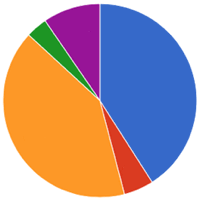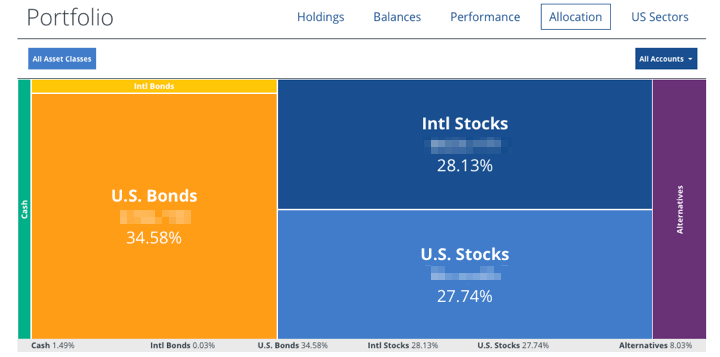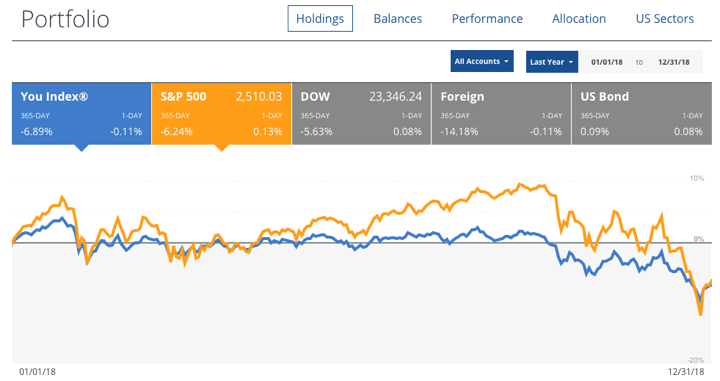
Here’s my final quarterly portfolio update for Q4 2018. This is how I track my real-world holdings, including 401k/403b/IRAs and taxable brokerage accounts but excluding our house, cash reserves, and a few side investments. The goal of this portfolio is to create enough income to cover our household expenses. As of 2018, we are “semi-retired” and have started spending a portion of our dividends and interest from this portfolio.
Actual Asset Allocation and Holdings
I use both Personal Capital and a custom Google Spreadsheet to track my investment holdings. The Personal Capital financial tracking app (free, my review) automatically logs into my accounts, adds up my balances, tracks my performance, and calculates my asset allocation. I still use my manual Google Spreadsheet (free, instructions) because it helps me calculate how much I need in each asset class to rebalance back towards my target asset allocation.
Here are my YTD performance and current asset allocation visually, per the “Holdings” and “Allocation” tabs of my Personal Capital account, respectively:

Stock Holdings
Vanguard Total Stock Market Fund (VTI, VTSMX, VTSAX)
Vanguard Total International Stock Market Fund (VXUS, VGTSX, VTIAX)
WisdomTree SmallCap Dividend ETF (DES)
Vanguard Small Value ETF (VBR)
Vanguard Emerging Markets ETF (VWO)
Vanguard REIT Index Fund (VNQ, VGSIX, VGSLX)
Bond Holdings
Vanguard Limited-Term Tax-Exempt Fund (VMLTX, VMLUX)
Vanguard Intermediate-Term Tax-Exempt Fund (VWITX, VWIUX)
Vanguard Intermediate-Term Treasury Fund (VFITX, VFIUX)
Vanguard Inflation-Protected Securities Fund (VIPSX, VAIPX)
Fidelity Inflation-Protected Bond Index Fund (FIPDX)
iShares Barclays TIPS Bond ETF (TIP)
Individual TIPS securities
U.S. Savings Bonds (Series I)
Target Asset Allocation. Our overall goal is to include asset classes that will provide long-term returns above inflation, distribute income via dividends and interest, and finally offer some historical tendencies to balance each other out. I make a small bet that US Small Value and Emerging Markets will have higher future long-term returns (along with some higher volatility) than the more large and broad indexes, although I could be wrong. I don’t hold commodities, gold, or bitcoin as they don’t provide any income and I don’t believe they’ll outpace inflation significantly.
I believe that it is important to imagine an asset class doing poorly for a long time, with bad news constantly surrounding it, and only hold the ones where you still think you can maintain faith based on a solid foundation of knowledge and experience.
Stocks Breakdown
- 38% US Total Market
- 7% US Small-Cap Value
- 38% International Total Market
- 7% Emerging Markets
- 10% US Real Estate (REIT)
Bonds Breakdown
- 50% High-quality, Intermediate-Term Bonds
- 50% US Treasury Inflation-Protected Bonds
I have settled into a long-term target ratio of 67% stocks and 33% bonds (2:1 ratio) within our investment strategy of buy, hold, and occasionally rebalance. (Small changes to 65/35 or 70/30 are also fine.) With a self-managed, simple portfolio of low-cost funds, we minimize management fees, commissions, and taxes.
Holdings commentary. On the bond side, I still like high-quality bonds with a short-to-intermediate duration of under 5 years or so. This means US Treasuries, TIPS, or investment-grade municipal bonds. I don’t want to worry about my bonds. Right now, my bond portfolio is about 1/3rd muni bonds, 1/3rd treasury bonds, and 1/3rd inflation-linked treasury bonds (and savings bonds).
On the stocks side, I made a few comments in my 2018 year-end asset class return review. US stocks went down in 2018, but international and emerging markets stocks did even worse. On the flipside, international and emerging markets are a lot cheaper based on various metrics. I remain satisfied with my mix, knowing that I will own whatever successful businesses come out of the US, China, or wherever in the future.
Performance commentary. According to Personal Capital, my portfolio went down 6.9% in 2018. I see that during the same period the S&P 500 has lost 6% (excludes dividends), Foreign Developed stocks lost 14%, and the US Aggregate bond index was basically flat. Of course I didn’t want to see my value fall, but most of the change was due to a lower P/E ratio as opposed to lower earnings from companies.
An alternative benchmark for my portfolio is 50% Vanguard LifeStrategy Growth Fund and 50% Vanguard LifeStrategy Moderate Growth Fund – one is 60/40 and the other is 80/20 so it also works out to 70% stocks and 30% bonds. That benchmark would have a total return of -5.9% for 2018.
I’ll share about more about the income aspect in a separate post.

 The Best Credit Card Bonus Offers – 2025
The Best Credit Card Bonus Offers – 2025 Big List of Free Stocks from Brokerage Apps
Big List of Free Stocks from Brokerage Apps Best Interest Rates on Cash - 2025
Best Interest Rates on Cash - 2025 Free Credit Scores x 3 + Free Credit Monitoring
Free Credit Scores x 3 + Free Credit Monitoring Best No Fee 0% APR Balance Transfer Offers
Best No Fee 0% APR Balance Transfer Offers Little-Known Cellular Data Plans That Can Save Big Money
Little-Known Cellular Data Plans That Can Save Big Money How To Haggle Your Cable or Direct TV Bill
How To Haggle Your Cable or Direct TV Bill Big List of Free Consumer Data Reports (Credit, Rent, Work)
Big List of Free Consumer Data Reports (Credit, Rent, Work)
Jonathan, to confirm — it looks like you’re including your 401K in your asset breakdown, correct? Did you actively manage your 401K portfolio or stick with one of the “T-Shirt” sizes offered by the investment company?
Yes, I actively pick the funds in my 401k. I use the Schwab brokerage window on one and my Solo 401k lets me buy whatever I want. I don’t use any of the Target date funds (T Rowe Price available in one).
Jonathan, not sure if you’re written a post on this, but what is the advantage of actively picking ETFs/Mutual Funds for a retirement account vs. the low-cost target funds in Vanguard and Schwab? I know the experts say I shouldn’t be using a target fund, even the super low expense ones (less than 0.10%, but I’m not sure why.
I’m actually a supporter of low-cost Target funds like Vanguard Target Retirement and Fidelity Freedom INDEX funds.
I prefer building my own mix because I am a DIY kind of person and like the control to pick what asset classes I like (such as muni bonds) and manage asset location for tax efficiency.
Jonathan,
I notice you lost 1% return to your benchmark. I also track my portfolio against a Vanguard target mutual fund / benchmark and did not match it. My mix is very similar to yours. I only beat the taget fund twice in 8 years. Its not initiative to me that i can’t at least match a target fund but the YE numbers say otherwise. I enjoy maniging my portfolio but can’t afford losing to a target fund. Would love your thoughts as you may have the same issue.
It’s true, I have made some bets with my personal portfolio that may make it perform worse than a Target fund. It did this year because I am 50% US and 50% International, while my benchmark is 60% US and 40% International. US has done better than international this year (and over the past decade really). I also hold extra in Small Value and Emerging Market, which did worse than their vanilla alternatives.
Ah, the tax efficiency point is a good one that could apply to anyone. In simplest terms, does that mean holding bonds in your 401k/SEP and stocks in your Roth/regular brokerage accounts?
[Responding to Avi below – I don’t see a reply link on his comment.]
https://www.bogleheads.org/wiki/Tax-efficient_fund_placement#Tax_efficiency_of_bonds
Thanks Thomas, I’ll take a look.
Jonathan,
Looking good. I am curious how you are managing family health insurance in your semi-retired position? Would you mind sharing if you were able to get employer health insurance benefits in your part-time positions or going another route?
Nice to hear from you, 2million. My spouse basically negotiated for keeping her health insurance as part of her 50% of full-time contract. However, it is essentially taken out of her income, but health insurance isn’t counted as taxable income so it’s a slight win. We also retain access to other goodies like a 401k, Healthcare FSA and Dependent care FSA, so that’s nice. As long as my wife and I can juggle young childcare duties between us, we like this arrangement.
That is great. Appreciate you sharing. I think if I could negotiate healthcare benefits into a sustainable part-time position I’d be ready to downshift in the next year. I think healthcare is such a wildcard for retirement/financial freedom expenses and Im worried about a mis-step.
Hi 🙂
Did you ever consider peer to peer lending?
Have a good time.
Peter Michael